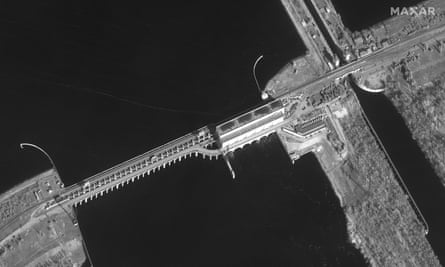In the early hours on Tuesday, footage began to emerge of water spilling from the strategically important Nova Kakhovka dam in southern Ukraine. The Ukraine army’s southern military command said the dam had been blown up by Russian forces. The local Russian-installed mayor has called it a “terrorist act”.
Nova Kakhovka dam on the Dnipro River lies about 20 miles (30km) east of the city of Kherson. Its destruction will have a number of significant repercussions for the local area – and for Ukraine’s wider war effort.
Why is Nova Kakhovka dam significant?
The dam traverses Ukraine’s enormous Dnipro River, holding back a huge reservoir of water. The dam itself is 30 metres tall and hundreds of metres wide. It was built in 1956 as part of the Kakhovka hydroelectric power plant.
The reservoir it contains holds an estimated 18 cubic kilometres of water, about the same volume as the Great Salt Lake in Utah. Bursting the dam could send a wall of water flooding settlements below it, including Kherson, which Ukrainian forces recaptured in late 2022.
Soon after Ukraine accused Russia of blowing up the dam, the head of the Kherson region urged residents to evacuate the area warning that “water will reach a critical level in 5 hours”.
Water from the reservoir supplies the Crimean peninsula to the south, which was annexed by Russia in 2014, as well as the Zaporizhzhia nuclear plant, Europe’s largest, to the north.
It also helps power the Kakhovka hydroelectric plant. Its destruction will add to Ukraine’s ongoing energy problems, after Russia spent weeks earlier this year targeting vital infrastructure.
It will also be likely to wreck the canal system that irrigates much of southern Ukraine, including Crimea.

Has it been threatened before?
Since the start of Russia’s war against Ukraine, the Nova Kakhovka dam has been earmarked as a potential target for both its strategic importance – as well as the damage that its destruction would unleash. It was captured by Russia at the start of Moscow’s February 2022 invasion, and has been held by it ever since.
In October, as Ukraine was in the midst of reclaiming large parts of occupied Kherson, Volodymyr Zelenskiy urged the west to warn Russia not to blow up the dam, warning that it would flood a large area of southern Ukraine. At the time, he claimed that Russian forces had planted explosives inside the dam.
Zelenskiy said “destroying the dam would mean a large-scale disaster” and compared such an act to the use of weapons of mass destruction.
Ukraine military intelligence said “the scale of the ecological disaster [would] go far beyond the borders of Ukraine and affect the entire Black Sea region”.
At the same time, Russia accused Kyiv of rocketing the dam and planning to destroy it.
After Ukraine recaptured Kherson in November, images emerged of some significant damage to the dam. Russia had accused Ukraine of shelling the dam in its campaign to recapture Kherson.

What has been happening this year?
In May, residents in a nearby village reported ongoing flooding which they blamed on Russia’s occupation of Nova Kakhovka. Speaking to the Reuters news agency, locals said the water level had begun to rise in April, sometimes by up to 30cm a day, and had remained elevated since.
Ukrainian officials said the rise of the Dnipro’s water level, “as a result of which settlements in the Zaporizhzhia region were flooded, is linked to the Russian occupation of the Kakhovka dam”.
But they added that they were unable to say what exactly Russian forces were doing at the dam because they did not have access themselves.
A Russian energy official said in May that the dam risked being overwhelmed by record-high water levels.
Reuters contributed to this report
https://news.google.com/rss/articles/CBMijAFodHRwczovL3d3dy50aGVndWFyZGlhbi5jb20vd29ybGQvMjAyMy9qdW4vMDYvbm92YS1rYWtob3ZrYS1kYW0tZXZlcnl0aGluZy15b3UtbmVlZC10by1rbm93LWFib3V0LXVrcmFpbmVzLXN0cmF0ZWdpY2FsbHktaW1wb3J0YW50LXJlc2Vydm9pctIBAA?oc=5
2023-06-06 22:52:00Z
2109640738
Tidak ada komentar:
Posting Komentar